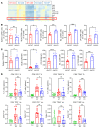Donor T cell DNMT3a regulates alloreactivity in mouse models of hematopoietic stem cell transplantation
- PMID: 35608905
- PMCID: PMC9246380
- DOI: 10.1172/JCI158047
Donor T cell DNMT3a regulates alloreactivity in mouse models of hematopoietic stem cell transplantation
Abstract
DNA methyltransferase 3a (DNMT3a) is an important part of the epigenetic machinery that stabilizes patterns of activated T cell responses. We hypothesized that donor T cell DNMT3a regulates alloreactivity after allogeneic blood and marrow transplantation (allo-BMT). T cell conditional Dnmt3a KO mice were used as donors in allo-BMT models. Mice receiving allo-BMT from KO donors developed severe acute graft-versus-host disease (aGVHD), with increases in inflammatory cytokine levels and organ histopathology scores. KO T cells migrated and proliferated in secondary lymphoid organs earlier and demonstrated an advantage in trafficking to the small intestine. Donor T cell subsets were purified after BMT for whole-genome bisulfite sequencing (WGBS) and RNA-Seq. KO T cells had global methylation similar to that of WT cells, with distinct, localized areas of hypomethylation. Using a highly sensitive computational method, we produced a comprehensive profile of the altered epigenome landscape. Hypomethylation corresponded with changes in gene expression in several pathways of T cell signaling and differentiation. Additionally, Dnmt3a-KO T cells resulted in superior graft-versus-tumor activity. Our findings demonstrate a critical role for DNMT3a in regulating T cell alloreactivity and reveal pathways that control T cell tolerance. These results also provide a platform for deciphering clinical data that associate donor DNMT3a mutations with increased GVHD, decreased relapse, and improved survival.
Keywords: Bone marrow transplantation; Cellular immune response; Epigenetics; Transplantation.
Figures








Similar articles
-
Ceacam1 separates graft-versus-host-disease from graft-versus-tumor activity after experimental allogeneic bone marrow transplantation.PLoS One. 2011;6(7):e21611. doi: 10.1371/journal.pone.0021611. Epub 2011 Jul 6. PLoS One. 2011. PMID: 21760897 Free PMC article.
-
Donor T-Cell Repertoire Profiling in Recipient Lymphoid and Parenchyma Organs Reveals GVHD Pathogenesis at Clonal Levels After Bone Marrow Transplantation in Mice.Front Immunol. 2021 Dec 7;12:778996. doi: 10.3389/fimmu.2021.778996. eCollection 2021. Front Immunol. 2021. PMID: 34950143 Free PMC article.
-
Modulation of Immune Checkpoints and Graft-versus-Leukemia in Allogeneic Transplants by Antagonizing Vasoactive Intestinal Peptide Signaling.Cancer Res. 2016 Dec 1;76(23):6802-6815. doi: 10.1158/0008-5472.CAN-16-0427. Epub 2016 Sep 26. Cancer Res. 2016. PMID: 27671676 Free PMC article.
-
Alloreactivity as therapeutic principle in the treatment of hematologic malignancies. Studies of clinical and immunologic aspects of allogeneic hematopoietic cell transplantation with nonmyeloablative conditioning.Dan Med Bull. 2007 May;54(2):112-39. Dan Med Bull. 2007. PMID: 17521527 Review.
-
Alloreactivity and the predictive value of anti-recipient specific interleukin 2 producing helper T lymphocyte precursor frequencies for alloreactivity after bone marrow transplantation.Dan Med Bull. 2002 May;49(2):89-108. Dan Med Bull. 2002. PMID: 12064093 Review.
Cited by
-
Significance of targeting DNMT3A mutations in AML.Ann Hematol. 2025 Mar;104(3):1399-1414. doi: 10.1007/s00277-024-05885-8. Epub 2024 Jul 30. Ann Hematol. 2025. PMID: 39078434 Free PMC article. Review.
-
Clonal Hematopoiesis-Associated Gene Mutations Affect Acute Graft-Versus-Host Disease After Hematopoietic Stem Cell Transplantation in AML Patients.Ann Transplant. 2024 Jul 2;29:e943688. doi: 10.12659/AOT.943688. Ann Transplant. 2024. PMID: 38952007 Free PMC article.
-
Hematopoietic stem cell aging and leukemia transformation.Blood. 2023 Aug 10;142(6):533-542. doi: 10.1182/blood.2022017933. Blood. 2023. PMID: 36800569 Free PMC article.
-
The impact of epigenetic modifications on allogeneic hematopoietic stem cell transplantation.Front Immunol. 2023 May 31;14:1188853. doi: 10.3389/fimmu.2023.1188853. eCollection 2023. Front Immunol. 2023. PMID: 37325668 Free PMC article. Review.
-
Clonal hematopoiesis in the setting of hematopoietic cell transplantation.Semin Hematol. 2024 Feb;61(1):9-15. doi: 10.1053/j.seminhematol.2024.01.011. Epub 2024 Feb 1. Semin Hematol. 2024. PMID: 38429201 Free PMC article.
References
-
- Mary M. Horowitz. Thomas’ Hematopoietic Cell Transplantation: Stem Cell Transplantation. Fifth ed: Wiley; 2015:8–17.
Publication types
MeSH terms
Grants and funding
LinkOut - more resources
Full Text Sources
Molecular Biology Databases
Research Materials

